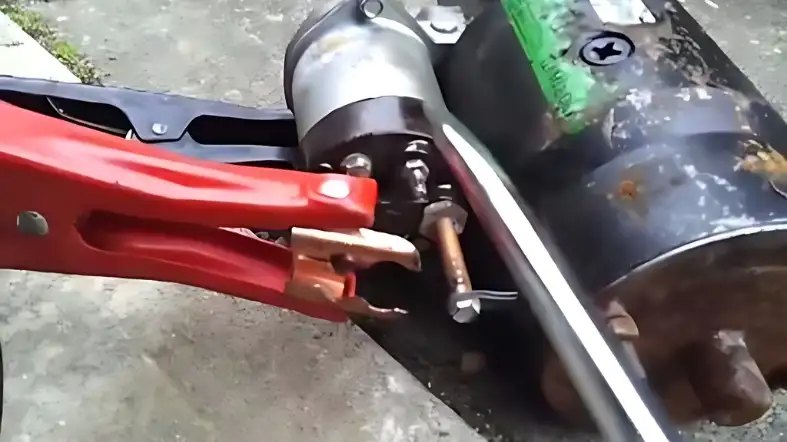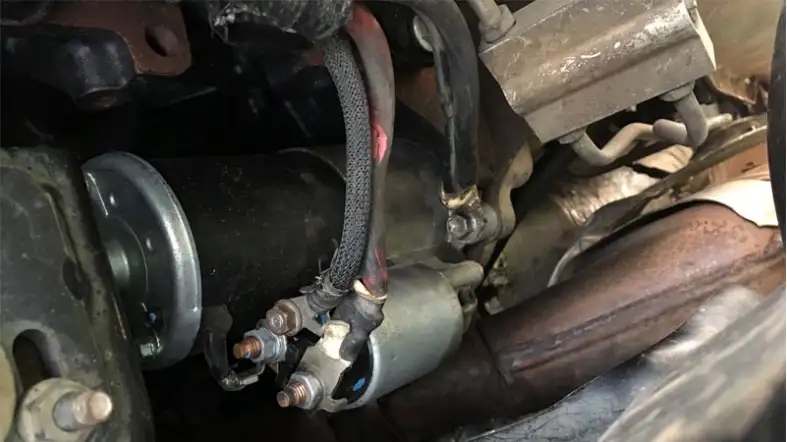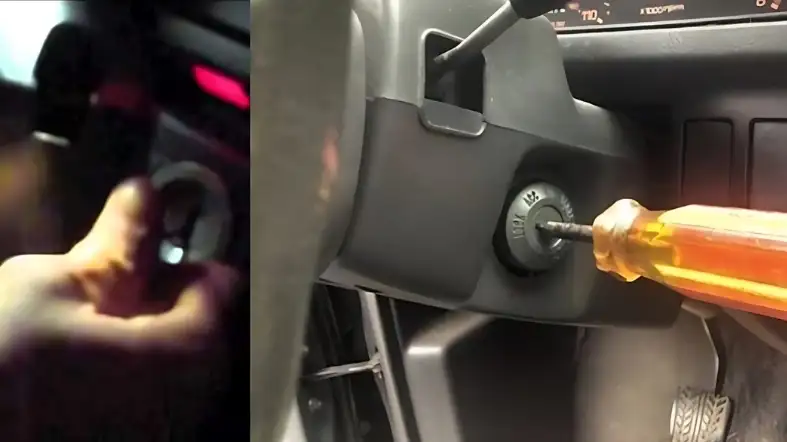You’re all set for a thrilling adventure, ready to conquer the open road, only to be confronted by a stubborn and lifeless engine.
A bad starter! So, today we’re going to dive headfirst into the realm of automotive wizardry and show you how to bring your beloved four-wheeled companion back to life using nothing more than a trusty screwdriver and a touch of resourcefulness.
We’ll take you step by step through the process, from identifying the signs of a faulty starter to wielding your screwdriver with finesse, all the way to successfully starting your engine and getting back on the road.
How to start a car with a bad starter with a screwdriver?
Here are the tools you will need and a step-by-step guide to help you get your car running:

1. Screwdriver:
Look for a flathead screwdriver with a comfortable grip. It should be long enough to reach the ignition switch easily.
2. Flashlight:
A flashlight will come in handy if you need to work in low-light conditions, especially if the starter is located in a difficult-to-access area.
3. Safety gloves:
It’s important to protect your hands while working on your car. Wear a pair of gloves to prevent any injuries or discomfort.
If you’re having trouble starting your car, here are a few general suggestions to consider:
1. Check the battery:
Make sure the battery is properly connected and charged. Look for signs of corrosion or loose connections.
If necessary, jump-start the car using jumper cables and a working vehicle.
2. Examine the ignition switch:
The ignition switch could be faulty. Try wiggling the key or using a spare key if available. If the switch is damaged, it may need to be replaced by a professional.
3. Inspect the starter motor:
The starter motor is responsible for turning the engine over when you start the car.
If it’s not working properly, you may hear a clicking sound or the engine may not crank. A bad starter motor will generally require replacement.
4. Verify the starter solenoid:
The starter solenoid is a smaller component connected to the starter motor. It helps transmit electrical current from the battery to the starter motor.
If the solenoid is faulty, it can prevent the car from starting. A professional can test and replace the solenoid if necessary.
5. Seek professional assistance:
If you’ve tried these basic troubleshooting steps and your car still won’t start, it’s best to consult a qualified mechanic.
They have the expertise and equipment to diagnose and fix the specific issue with your car’s starter.
How to locate the starter and the battery?

If you’re trying to start a car with a bad starter, locating the starter and the battery is essential. Here’s a step-by-step guide to help you find these components:
1. Pop the hood:
First, ensure that your car is parked in a safe location and the engine is turned off.
Locate the hood release lever, usually located inside the vehicle near the driver’s side footwell, and pull it to release the hood.
2. Find the battery:
The battery is generally positioned in the engine compartment. It’s a rectangular-shaped box with two terminals, usually covered with plastic or rubber housing.
Look for a red (positive) and black (negative) terminal. The battery may be located on either side of the engine bay, typically near the front.
3. Locate the starter:
The starter motor is usually attached to the engine block or the transmission housing.
It’s a cylindrical or rectangular component with wires connected to it.
The exact location can vary depending on the car make and model, but it’s commonly found on the lower side of the engine, near the transmission or flywheel.
4. Refer to your car’s manual:
If you’re having trouble identifying the battery or starter, consult your vehicle’s owner’s manual.
It will provide you with specific instructions and diagrams to locate these components based on your car’s make and model.
5. Check online resources:
If you don’t have access to the manual or need further guidance, you can search for your car’s make, model, and year online along with keywords like “starter location” or “battery location.”
Many automotive forums and websites provide detailed instructions with images or videos to help you find these components
What are the risks of starting a car with a screwdriver?

Starting a car with a screwdriver is a risky endeavor that can have serious consequences.
While it may seem like a quick solution to a problem, it is important to understand the potential dangers involved.
Here are several points that highlight the risks of starting a car with a screwdriver:
1. Electrical hazards:
Modern cars rely on complex electrical systems to start and operate.
Attempting to start a car with a screwdriver bypasses the ignition system, which can lead to electrical malfunctions.
The risk of electrical shock or damage to sensitive components is significantly increased.
2. Damage to the ignition system:
The ignition system of a car is designed to provide the necessary spark to start the engine.
By using a screwdriver, you risk damaging critical components such as the ignition switch or the ignition lock cylinder.
This can result in expensive repairs or even render the car inoperable.
3. Safety concerns:
When starting a car with a screwdriver, you bypass important safety features built into the ignition system.
These features include the steering wheel lock, gear interlock, and immobilizer.
Disabling these safety mechanisms can lead to unintended movement of the vehicle or potential theft.
4. Fire hazard:
Cars have fuel systems that are carefully designed to prevent leaks and ensure proper fuel delivery.
By using a screwdriver to start a car, you risk causing damage to the fuel lines or injectors. This can lead to fuel leaks, increasing the chances of a fire or explosion.
5. Warranty and insurance implications:
Starting a car with a screwdriver is considered improper and unauthorized use.
If your car is under warranty, attempting such a start could void the warranty and leave you responsible for any repairs.
Additionally, insurance companies may deny coverage for any damages resulting from using a screwdriver to start a car.
6. Legal repercussions:
Depending on your jurisdiction, starting a car with a screwdriver could be considered illegal.
It may be viewed as unauthorized access or tampering with a vehicle’s ignition system.
Engaging in such activities can result in fines, penalties, or even criminal charges.
7. Lack of control and unpredictability:
When you use a screwdriver to start a car, you have limited control over the engine and its functions.
This can lead to unpredictable behavior, such as the engine running at high RPM or experiencing a sudden stall.
Such situations can be dangerous, especially if they occur while driving.
FAQs
Can I Really Start A Car With A Bad Starter Using A Screwdriver?
Yes, it is possible to start a car with a bad starter using a screwdriver as a temporary solution.
However, please note that this method is not a permanent fix and should only be used in emergencies.
Why Would I Need To Start My Car With A Bad Starter Using A Screwdriver?
A bad starter can leave you stranded with a car that won’t start.
In such situations, using a screwdriver to bypass the starter can provide a temporary solution to get your car running and get you to a mechanic or a safer location.
Is This Method Safe For My Car?
Starting your car with a screwdriver can be a temporary solution, but it is not recommended as a long-term fix.
While it can get your car running, it bypasses the safety mechanisms built into the ignition switch.
This can potentially damage your car’s electrical system or cause other issues.
It’s important to have a professional mechanic diagnose and repair the faulty starter as soon as possible.
Can I Start Any Car With A Bad Starter Using A Screwdriver?
The method of starting a car with a screwdriver can work for many cars, but not all.
It depends on the make and model of your vehicle.
Additionally, newer car models often have advanced security features that may prevent this method from working.
How Long Can I Drive My Car After Starting It With A Screwdriver?
Starting your car with a screwdriver is meant to be a temporary solution to get your vehicle running.
It is not recommended to drive for long distances or extended periods using this method.
It’s best to have the starter repaired or replaced by a professional mechanic as soon as possible.
Can I Use This Method If My Car Has A Push-Button Start?
No, the method of starting a car with a screwdriver is not applicable to vehicles with a push-button start.
These modern ignition systems have complex electronics and security features that make this method ineffective.
In such cases, it’s best to contact a roadside assistance service or a professional mechanic for assistance.
Can I Avoid Starting My Car With A Screwdriver Altogether?
Starting your car with a screwdriver is meant to be a temporary solution.
To avoid this method altogether, it’s recommended to have your car regularly maintained and inspected by a qualified mechanic.
This way, any potential issues with the starter can be detected early on and addressed before they become major problems.
Conclusion
When you face this frustrating situation of a bad starter in your car, it’s helpful to know an alternative method to get your engine running using a simple tool like a screwdriver.
While it’s important to remember that this method should only be used in emergencies and as a temporary solution, it can provide temporary relief until you’re able to address the underlying issue.
Starting your car with a screwdriver should only be used as a last resort or in emergency situations. It’s not a substitute for proper maintenance or professional repair.
